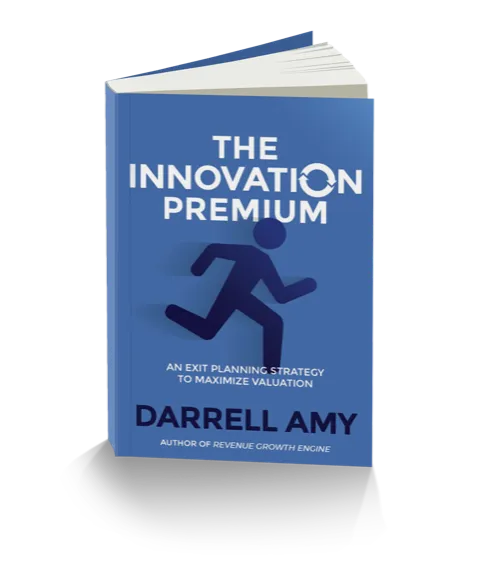THE VALUE CREATION BLOG

Five Ways Sales Growth Helps (or Hurts) Enterprise Value
Not all revenue is created equal. Some types of sales growth drive more enterprise value than others. Smart business owners and executives recognize the ways that sales growth affects enterprise value.
Here are the top ways sales growth can be helping or hurting enterprise value:
1. One-Time vs. Recurring Revenue
Project revenue has a much lower value than recurring revenue. Salespeople love the excitement (and commission) of closing the big project deal. However, when it comes to building enterprise value, a steadily growing stream of recurring revenue is worth way more than one-time revenue. This makes sense when you realize that a business is typically valued based on expected future cash flow. Recurring revenue makes future cash flow much more predictable than hoping the sales team can continue to land projects.
2. Handshake vs. Contracted Revenue
“Our customers love us!” Virtually every business owner I’ve met believes that’s true. You may be in a highly relational business and believe that a handshake is more than enough. However, without contracts in place, the revenue is always at risk. Plus, if the business is truly built on a relationship, what happens when the business changes hands? Smart buyers recognize the importance of contracts and will discount an offer based on the existence and quality of the contracts.
3. Owner-Driven vs. Sales-Driven
Founder-dependence is a massive drain on company value. This is especially true when the founder wears the sales hat for the most important accounts. As the owner, it may feel good to be engaged with top accounts. However, the danger is that a buyer will tend to discount a business as they consider those accounts at risk if the owner leaves. The alternative to discounting is even worse. The buyer will expect the owner to stay on for an earn-out to ensure the key accounts remain solid.
4. Superstar vs. Regular Reps
Did the sales growth come from a superstar salesperson or was sales growth spread across the team? If you live by the superstar rep, you die by the superstar rep. Just as founder-dependence hurts the value of a company, superstar rep dependence also makes the buyer nervous about what happens if that top rep leaves. There are several possible solutions to this problem, but the best one is to ensure that the entire sales team is trained, coached, and enabled in a culture that supports high performance.
5. One Whale vs. Lots of Nice Fish
Just as salespeople like winning big project deals, they also like landing the whale accounts. While having major accounts can be good for a business, many times I’ve seen the business bend over backwards to serve a major account that is barely profitable. Since profit ultimately drives valuation, the low-profit revenue from this account has a negligible impact on enterprise value. Often the business directs a disproportionate amount of resources to the whale, reducing the level of attention and service given to other accounts.
Bonus: Fake Growth Because of Inflation
Last week I heard an excited business commentator say that GDP growth in the USA was 2.8%. Not to be a wet blanket here, but how much of the GDP growth was related to higher costs because of inflation? If you factor inflation into the mix, the GDP growth may be the opposite of exciting. In an inflationary period, businesses must factor inflation into what they actually call growth.
Sales get lulled into a false sense of success when inflation is not factored in. We’ve seen this over the past few years when asking a business owner about their sales growth. “We had a pretty good year! We grew 8% even in a tough market.” Yes, but how much did you increase your prices? If the price increase was 10% during that time period, the sales team effectively shrank by 2%. Plus, since the value of the dollar decreases year over year, inflation took an even bigger chunk. Year-over-year sales goals (and quotas) need to factor inflation into the mix. A price increase does grow revenue, but it does not represent business growth.
Action Items
There are many other things that could be added to this list. The point is that all revenue is not created equal. Some types of revenue drive enterprise value more than others. It is important for a business to understand how their sales practices and results are affecting the most important number: enterprise value.
1. Know Your Current Enterprise Value
It shocks me how few businesses know their current enterprise value. When it comes to the most important number in managing a business, enterprise value is often based on hearsay about what multiple some other business in the industry got during a sale. (We all know that no one exaggerates.) It is important for every business to have enterprise value on their scorecard. Of course, a business is only worth what a buyer is willing to pay. Fortunately, software and data analytics allow you to benchmark your business against other recent business sales. The software also factors in the items discussed in this article, along with many other fixable issues that drain the value of a business. (To learn more, visit https://value.valuecreationengines.com.)
2. Know How Much Money Your Sales Team is Leaving On the Table
You also need to understand how much money your sales team could be bringing in were they properly trained, coached, and enabled. The solution to sales problems is typically to hire more reps. However, hiring reps is incredibly expensive, if you can find them. Instead, smart businesses leverage data analytics to benchmark their sales team against the core competencies of sales. This not only gives an understanding of how much money is being left on the table, it also helps create a plan to improve the skills of the team, driving enterprise value. (For more on this Sales Team Evaluation, send me a private message.)
3. Create a Plan to Grow Enterprise Value
Armed with the knowledge about the current enterprise value and the potential of the sales team, you are now ready to create an effective plan to resolve the issues that hold back your enterprise value. You can implement strategies that drive predictable and profitable sales growth.
At the end of the day, this will focus your leadership team on driving value. This prepares the company to go on the market. Or, it may just make you fall in love with your business all the more. Either way is a win!
Discover the Enterprise Value of Your Company and What's Holding It Back

https://value.valuecreationengines.com
Originally published on Darrell Amy's LinkedIn.
FREE BUSINESS VALUATION
What is Your Business Worth?
You can Discover the Value of Your Business in Less than 20 Minutes!
Join 70,000 business owners and get your score on the 8 Factors That Drive Your Company’s Value, a comprehensive analysis of your score and a detailed action plan for how to improve your score on each.


PREORDER YOUR FREE COPY NOW
Discover How to Create a Premium Valuation for Your Business
Learn how to command a premium multiple on your business
Find out why buyers discount their offers
See how innovation can help you create a premium valuation
Estimate your company's innovation index



